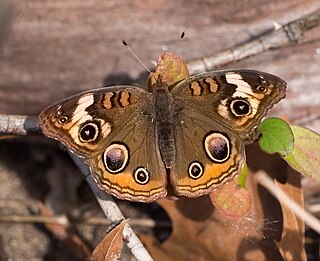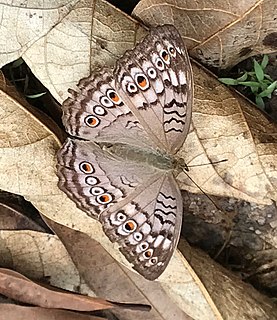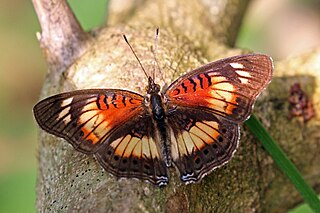
Junonia coenia, known as the common buckeye or buckeye, is a butterfly in the family Nymphalidae. It is found in all parts of the United States except the northwest, and is especially common in the South, the California coast, and throughout Central America. Its habitat is open areas with low vegetation and some bare ground. Its original ancestry has been traced to Africa, which then experiences divergence in Asia.

The Casuariiformes is an order of large flightless birds that has four surviving members: the three species of cassowary, and the only remaining species of emu. They are divided into either a single family, Casuariidae, or more typically two, with the emu splitting off into its own family, Dromaiidae.

Junonia atlites, the grey pansy, is a species of nymphalid butterfly found in South Asia.

Junonia is a genus of nymphalid butterflies, described by Jacob Hübner in 1819. They are commonly known as buckeyes, pansies or commodores. This genus flies on every continent except Antarctica. The genus contains roughly 30 to 35 species.

Junonia evarete, the Tropical Buckeye or West Indian buckeye, is a Neotropical butterfly of the Nymphalids (Nymphalidae) family. It has characteristic eye spots on the wings, which have a wingspan between 4.5 and 6.5 cm. This butterfly is easily confused with Junonia genoveva, the mangrove buckeye. Not only have the common names mangrove and tropical buckeye been confused, but the butterflies themselves have been sometimes misidentified in past literature, because the two species have many variations, subspecies and seasonal forms, which makes it difficult to identify or differentiate. Phylogenetic studies demonstrate the separation of evarete and genoveva, but evidence suggests that subspecies and perhaps additional species await their descriptions within this group.

Junonia oenone, the blue pansy or dark blue pansy, is a Nymphalid butterfly native to Africa. "Blue pansy" is also used in India to describe Junonia orithya.

Scaphella junonia, common names the junonia, or Juno's volute, is a species of large sea snail, a marine gastropod mollusk in the family Volutidae, the volutes.

Scaphella is a genus of large sea snails, marine gastropod mollusks in the family Volutidae, the volutes.

Junonia genoveva, the mangrove buckeye, is a butterfly of the family Nymphalidae. The species was first described by Pieter Cramer in 1780. It is found in North America from southern New Mexico, southern Arizona, southern Texas, and southern Florida south through the West Indies, Mexico and Central America to Argentina. Rare strays can be found up to southeastern California, southeastern Colorado and central Florida. In the Cayman Islands, it is known as the Caribbean buckeye.

Junonia terea, the soldier pansy or soldier commodore, is a butterfly of the family Nymphalidae. The species was first described by Dru Drury in 1773. It is found in the Afrotropical realm.

Junonia orithya is a nymphalid butterfly with many subspecies occurring from Africa, through southern and south-eastern Asia, Cambodia and in Australia. In India, its common English name is the blue pansy, but in southern Africa it is known as the eyed pansy as the name blue pansy refers to Junonia oenone. In Australia, this butterfly is known as the blue argus, but this name also is used for the Aricia anteros in Europe.

Junonia sophia, the little commodore or little pansy, is a butterfly in the family Nymphalidae. It is found in Senegal, the Gambia, Guinea-Bissau, Guinea, Sierra Leone, Liberia, Ivory Coast, Burkina Faso, Ghana, Togo, Nigeria, Cameroon, Angola, the Democratic Republic of the Congo, Uganda, Rwanda, Burundi, Kenya, Ethiopia, Tanzania, Malawi, and Zambia. The habitat consists of forests and savanna.

Junonia cymodoce, the blue leaf butterfly or blue leaf pansy, is a butterfly in the family Nymphalidae. It is found in Guinea, Ivory Coast, Ghana, Togo, Benin, Nigeria, Cameroon, Equatorial Guinea, São Tomé and Príncipe, the Republic of the Congo, Angola, the Central African Republic, the Democratic Republic of the Congo, western Uganda, western Tanzania and north-western Zambia. The habitat consists of lowland forests.

Iris junonia is a plant species in the genus Iris, it is also in the subgenus Iris. It is a rhizomatous perennial, from Cilicia, within the Taurus Mountains. It has glaucous short leaves, tall stems with several branches, numerous flowers in various colours from blue-purple, lavender, pale blue, cream, white and yellow, with brown veining and white tipped orange beards. It is cultivated as an ornamental plant in temperate regions. Its status is still unclear, if it is a synonym of Iris germanica or a separate species.

Phylloneura westermanni, Myristica bambootail is a damselfly species in the family Platycnemididae. It is endemic to Myristica swamps of Western Ghats in India. The habitat is restricted to a few localities in Karnataka, Kerala and Tamil Nadu.

Euxoa westermanni is a species of cutworm or dart moth in the family Noctuidae. It is found in North America.


















